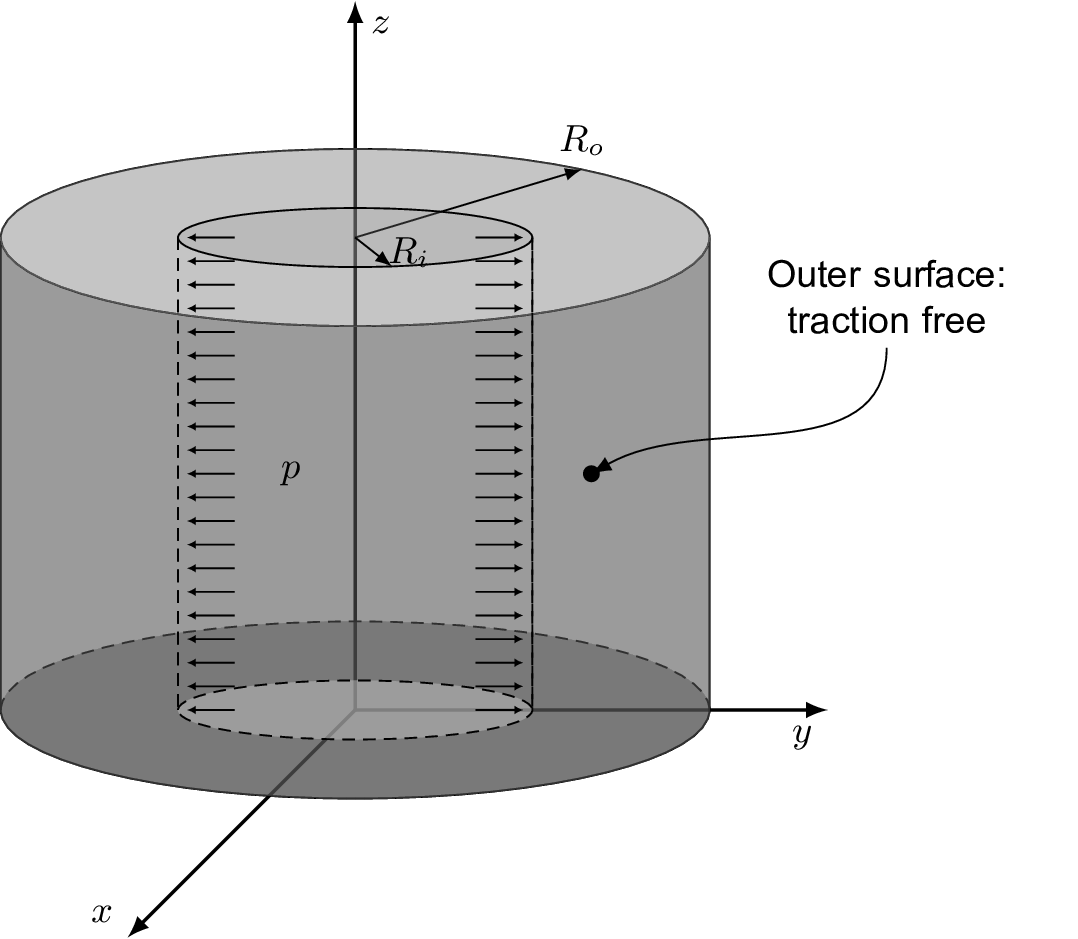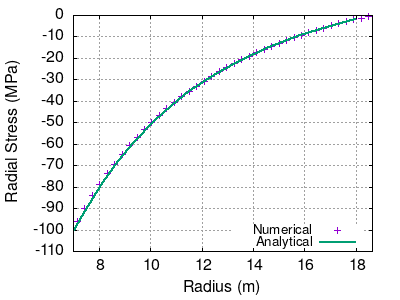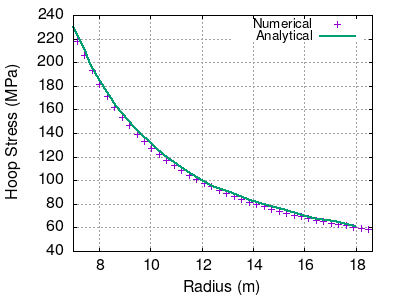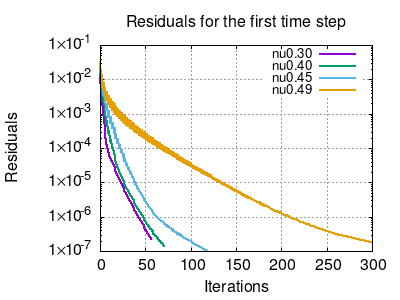Tutorial: cylindricalPressureVessel
Prepared by Iago Lessa de Oliveira
Tutorial Aims
- Exemplify the use of a hyperelastic mechanical law with large deformations;
- Assess the effect of the bulk modulus on the residual convergence of segregated algorithms for solids.
This tutorial currently only works with foam-extend-4.1.
Case Overview

Figure 1: Thick cylindrical vessel under inner pressure.
This benchmark consists of a thick cylindrical shell with an inner radius Ri = 7 m and outer radius Ro = 18.625 m. Its material is modelled as incompressible with the Mooney-Rivlin law with material parameters c10 = 80 MPa, c01 = 20 MPa, and c11 = 0.0 MPa. The strain state is assumed to be plane due to the geometric symmetry along the z-axis direction (see Figure 1). For the simulation, the inner pressure was linearly applied in equal increments along time until p = 100 MPa.
Due to symmetry, only a quarter of the cylinder section was simulated with a mesh density of 20 x 20 cells in the radial and circumferential directions, created using the blockMesh utility, respectively. A residual tolerance for the momentum equation of 10-6 was selected. For the results presented here, we employed the nonLinearGeometryTotalLagrangianTotalDisplacement model, one of the total Lagrangian approaches available that solves for the total displacement, which is why you have to use the D file in the directory 0/.
Expected Results
Figure 2 shows the radial and circumferential (or hoop stress) components of the Cauchy stress tensor along the undeformed radius of the cylinder when the inner pressure is equal to 100 MPa. To solve for the undeformed configuration, i.e. without automatically moving the mesh, you have to use one of the total Lagrangian formulations available. The solution reference was found in I. Bijelonja, I. Demirdžić, and S. Muzaferija, "A finite volume method for large strain analysis of incompressible hyperelastic materials," International Journal for Numerical Methods in Engineering, vol. 64, pp. 1594–1609, Nov. 2005


Figure 2: Radial (left) and circumferential, or hoop, stresses (right) along the radius of the cylinder.
The results shown in the plots of Figure 2 were obtained with a Poisson's ratio of 0.49, which yielded a Jacobian in the interval [0.98,0.99] for the last time-step. The Jacobian is the determinant of the deformation gradient (the F field that you find in the solution of non-linear cases), and should be equal to 1 when the solid is incompressible. The hyperelastic laws in solids4foam are implemented using a volumetric decomposition, where the deviatoric and volumetric portions of the constitutive law are modelled separately. In this case, the volumetric portion represents the isochoric motion of the solid and the compressibility of material can be set directly by using its bulk modulus (the field K in constant/mechanicalProperties), if available, or through the Poisson ratio (the scalar nu in constant/mechanicalProperties), where thus the bulk modulus is computed via the equation of the linearised theory.
By using this formulation, purely incompressible behaviour can be achieved by making either the bulk modulus "too large" or the Poisson ratio closer to 0.5. However, an important feature of displacement-based segregated solvers is that the convergence deteriorates as the incompressible behaviour is approximated. To demonstrate this, Figure 3 shows the residual drop of the first time step of the solution for four different values of the Poisson ratio, nu: 0.30, 0.40, 0.45, and 0.49.

Figure 3: Effect on convergence when approximating the purely incompressible behaviour in a solid.
It is important to have this in mind when using the non-linear mechanical laws implemented.
Data Availability
The results and gnuplot scripts used to generate the figures above are available in the solids4foam tutorials benchmark data repository.